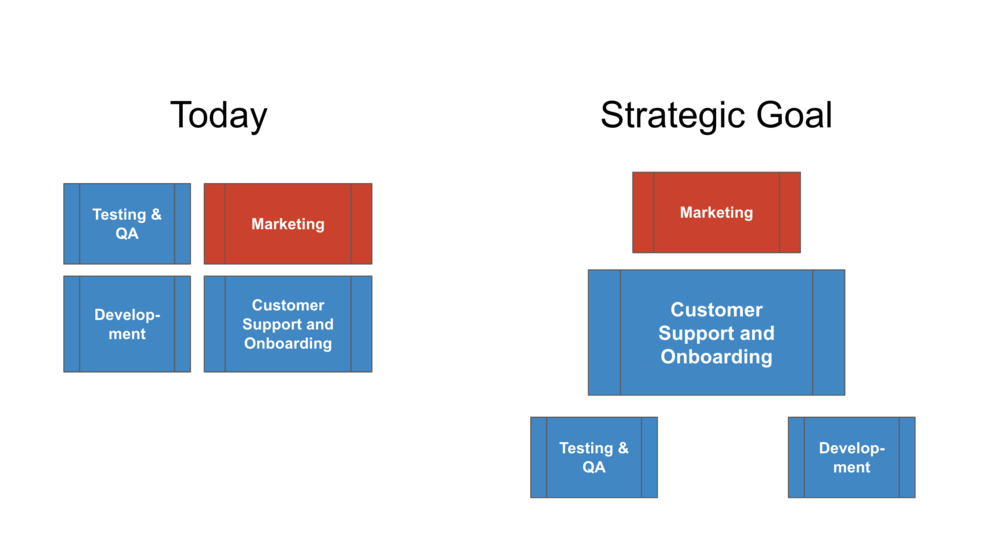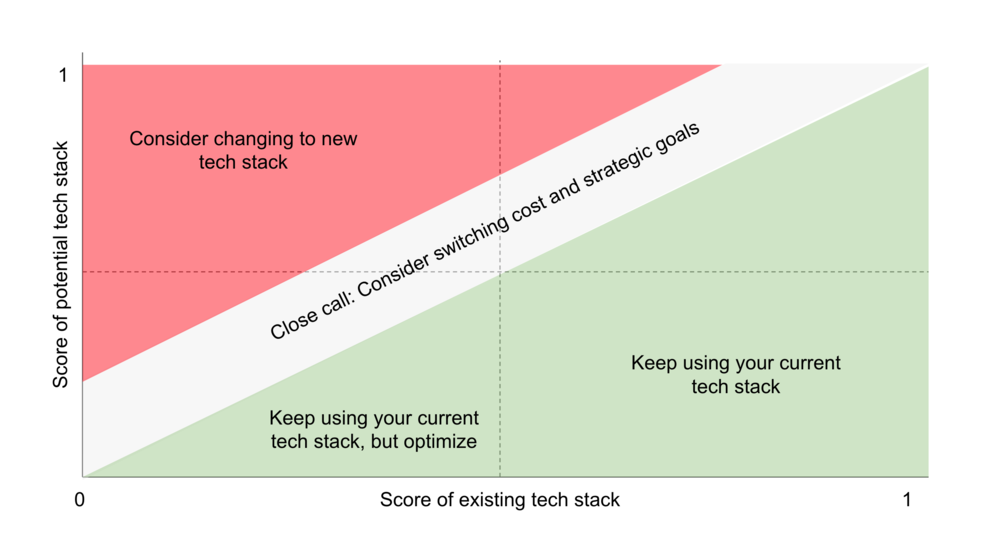
Tech Stack
What is a tech stack?
The term technology stack, or tech stack for short, has been coined in the tech and software industry. It describes the software and technology infrastructure that your organization uses to run a project, a website or the whole business.

Think about your technology stack as the sum of all software that you use. To get a comprehensive and meaningful picture, think of it as a network of software tools and consider how these tools are connected.
Reasons to review your tech stack
There’s a variety of reasons to review your current tech stack.
TIME
The most common reason to review your tech stack is time. For most companies that have been in business for a while, most software tools have been chosen some years back. Usually, the tech stack grows organically. As the software industry and the capabilities of technology solutions develop with high speed, it makes sense to tap into this newly available potential by updating your tech stack.
A COLLECTION OF WORKAROUNDS
As a business grows, the need for new processes and reporting arises. Usually, there’s a central software tool that had been chosen a while back. All the additional processes and reporting needs are then built around that software – often with several workarounds to make things work using the old software. The choice to create a workaround to save the effort of implementing a new core software makes sense only for so long – at a point, the pain of not being able to operate or report as you want grows more prominent than the fear of a tech relaunch.
NEW AND BETTER SOFTWARE TOOLS
You might have started with a tool that you adapted to do what you need. Let’s say you use MS Excel to document all your different customers. But then, there are tailored software offerings that do exactly what you need in a more sophisticated, safer way. A great reason to reconsider your choice of software, isn’t it?
GROWTH TRAJECTORY
When you are growing or are planning to expand, you quickly realize if software tools and processes don’t perform the way you need them to. Double or triple the number of instances and workarounds usually stop working as you’d need them to. So a critical part of preparing or managing growth is to review your software stack for scalability.
So if your business falls under one of these cases, it might be the right time to critically review the software you use.
Examine the foundation
To see whether your tech stack is suitable for the future of the business, we first should look at what your business actually needs. The goal is to find out what the critical processes are and then build your tech stack around these critical processes. Try to free your mind from your current software tools and think in a “what-should-be” mindset.
START WITH VALUE
We recommend making use of the lean methodology when starting your tech stack review. Lean focuses all business process designs around creating value for customers. So the first step in your tech stack review should be to define what actually is value for your customers. There’s a wealth of methodologies out there to identify value. Just search for “customer value” on the internet and pick a methodology that feels right.
IDENTIFY YOUR CORE PROCESSES
With the knowledge of what actually creates value for your clients, our next step is to cluster our processes into value-adding processes and non-value-adding processes.
Value-adding processes are the sequences of tasks you perform that actually generate value for your customers. Non-value-adding processes are processes that do not generate value for your customers.
A good question to ask yourself when examining a process: If my customer knew that I was doing this, would she be willing to pay me for it? This will give a feeling for whether a process generates value or not.
Even if a process does not generate value, it might still be necessary to run your business.
WHAT’S YOUR STRATEGY
As your strategy influences your value proposition, so it does influence what your ideal tech stack looks like. If your strategic positioning for the next 5 years includes becoming the competitor with the best customer support, your emphasis on customer support software will be high. If your goal is to become the most efficient low-cost supplier of a specific good, supply chain software might rather be on top of the list.

DEFINE THE REQUIREMENTS FOR YOUR CORE PROCESSES
We gotta jump one level deeper and examine the value-adding processes in more detail in the next step. Interview the experts in your team to get a deep understanding of how work is being performed. But even more important than that, your goal is to understand how a customer, a job or an item in production flows through your organization.
Build a list of things that are essential for your core processes to run smoothly. Again here, ask yourself for every process step whether it generates value and must be performed. If it is a yes, it becomes a requirement for your new software choice.
ADD NON-VALUE-ADDING REQUIREMENTS
Choose your top non-value-adding but necessary requirements that your software stack needs to have. The most important of these requirements is often reporting, both in a business intelligence and a financial reporting context. You want to have transparency over KPIs to manage your business and need to have your numbers right, so these two will often be mandatory requirements.
Assess your Tech Stack
EVALUATING YOUR CURRENT STACK
Take the requirements you have just written down and use them as a scorecard. Assess how well your current technology stack fulfills your requirements. Assign different scores:
- For a requirement that your software fulfills natively, i.e. with a built-in functionality, give 1 point.
- For a requirement that you currently only can fulfill with an integration, webhook or similar, assign 0.7 points.
- For a requirement that you currently only can fulfill with a workaround or some manual intervention, give 0.3 points.
- A requirement not fulfilled is 0 points.
- Add a strategic factor to it, that multiplies the summed up score of the requirements: If you think your tech stack will be able to support your companies strategic development in the next 5 years a 100%, than multiply with one. If you feel that your current tech stack already is at the end of its life-cycle, multiply with .5. Any value in between is possible as well.
Do this exercise, starting at the core processes and software tools and work your way “out” to the non-value-adding processes.
EVALUATING A FUTURE TACK
To find out whether it’s better to switch or to stick with your old tech stack, you have to assess a potential future tech stack in the same way.
- Find your core software: Your core software is the one that covers your core value adding processes. Besides your requirements, pay attention to how well it integrates to other software you potentially might use. The first software choice you make often has a strong influence on your whole tech stack, as you enter into an eco-system of integrations.
- Find your supporting and surrounding software choices and complete you new, potential tech stack.
- Assign points in the same scorecard process as above.
- Adjust your results down by a bit; Software descriptions and integration promises often sound like the perfect fit to what you’re looking for – limitations only become visible when actually implementing. Your scorecard results will automatically be biased towards a higher score. Be aware of that.
EVALUATING SWITCHING COST
Depending on the number of software tools you use, also consider switching cost when deciding about your tech stack. Switching cost can included:
- Cost of new software, compared to your current tech stack
- One-time implementation cost, e.g. for technical consultants or similar (can be a huge position, depending on the software)
- Cost caused by potential system down-time or limited availability of your services, shop or website
- Data-migration cost (many software companies offer migration services)
- Training cost and cost for change management
- Revision of Standard Operating Procedures etc
THE RESULT
Depending on the results of your analysis, the decision is very clear or a judgement call. Especially for the close calls, add your gut feeling to the mix. The below matrix shows you possible outcomes. In most cases, a potential future tech stack will receive much higher scores, so do considers switching cost.

Implementation or Maintenance
The next step will either be setting up an implementation project for your new tech stack or optimizing maintenance and use of your current tech stack, with some additions of tools here and there.
What’s your experience with your tech stack and the reviews thereof? Please share in the comments!
Best regards
Benjamin